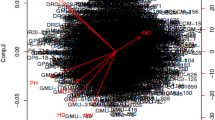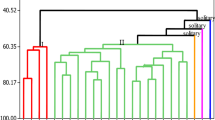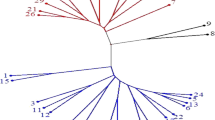Abstract
An investigation was conducted to determine the extent of diversity and relationships among a worldwide safflower (Carthamus tinctorius L.) germplasm collection and to find out adapted accessions that can be used in an organic safflower breeding program in Germany. A total of 468 accessions was studied under organic farming conditions at Kleinhohenheim experimental station during the seasons of 2004 and 2005. All the accessions were evaluated for 12 phenotypic traits and three rated diseases. Multivariate analyses have been used to measure the diversity in a subset of 200 accessions and 11 geographical regions. Generally, the study showed that there was a large genetic variation within accessions. A coefficient of variation (CV%) for investigated traits and diseases ranged from 2.9 to 91.0% with the highest CV was recorded for yield/m², yield/plant and seeds/plant. The most accessions that originated in Europe revealed relatively better performance compared to non-Europeans. High yielding, early maturing, and disease tolerant accessions were identified. However, the low oil content (8.7–22.8%) is the primary concern in this germplasm collection. The degree of heritability varied between 10% for lodging to 86% for plant height. Genotypic coefficient of correlation (r g) was slightly higher for many traits than the respective phenotypic coefficient. Oil content and seed yield/m² were highly significantly correlated (r g = 0.78). The genotypic coefficient of correlation showed that selection for seeds/plant and thousand kernel weight was effective for improvement of seed yield and oil content. The results of the principal component analysis and the clustering pattern of accessions were consistent with the results of analysis of variance. About 78% of the total phenotypic diversity in the germplasm was explained on the basis of four principal components and 88% of the total variation among geographical regions was contributed by the first three principal components. The distribution of the accessions within clusters has no apparent relationship with the geographical origin. However, many of the European accessions have a tendency to stay together.




Similar content being viewed by others
References
Agrawal RK, Kumar H, Singh RB, Singh RM (1982) Genetic divergence in safflower (Carthamus tinctorius L.). Madras Agric J 69(4):220–227
Akbar AA, Kamran M (2006) Relationship among yield components and selection criteria for yield improvement in safflower (Carthamus tinctorius L.). J Appl Sci 6(13):2853–2855
Alawala S, Suman A, Arro JA, Veremis JC, Kimbeng CA (2006) Target region amplification polymorphism (TRAP) for assessing genetic diversity in sugarcane germplasm collections. Crop Sci 46:448–455
Arslan B (2007) The path analysis of yield and its components in safflower (Carthamus tinctorius L.). J Biol Sci 7(4):668–672
Ashri A (1975) Evaluation of the germplasm collection of safflower (Carthamus tinctorius): distribution and regional divergence for morphological characters. Euphytica 24:651–659
Ashri A, Knowles PF (1960) Cytogenetics of safflower (Carthamus L.) species and their hybrids. Agronomy J 52:11–17
Ashri A, Zimmer DE, Urie AL, Knowles PF (1975) Evaluation of the germplasm collection of safflower (Carthamus tinctorius L.): VI. Length of planting to flowering period and plant height in Israel, Utah and Washington. Theor Appl Genet 46:359–364
Baker RJ (1986) Selection indices in plant breeding. CRC Press, Boca Raton
Banjamin HB, Shu G (1982) Interrelationships of morphological and economic characters of sunflower1. Crop Sci 22:817–822
Bartual R, Carbonell EA, Green DE (1985) Multivariate analysis of a collection of soybean cultivars for southeastern Spain. Euphytica 34:113–123
Bhatt E (1976) An application of multivariate analysis to selection for quality characters in wheat. Aust J Agric 27:11–18
Broich SL, Palmer RG (1980) A cluster analysis of wild and domesticated soybean phenotypes. Euphytica 29:23–32
Burger H, Schloen M, Schmidt W, Geiger HH (2007) Development of maize varieties with specific adaptation to organic farming conditions. In: 9.Wissenschaftstagung Ökologischer Landbau. Universität Hohenheim, Stuttgart, 20–23 März 2007, pp 245–248
Chaturvedi M, Srivastava N, Gudipati T, Bhadauria R, Khandelwal S, Das RR (2001) In vitro studies in the wild species of Carthamus—C. oxycantha L. In: Bergman J, Mündel HH (eds) Safflower: a multipurpose species with unexploited potential and world adaptability. Proceedings of the 5th international Safflower conference, Williston, ND, Sidney, MT, 23–27 July, pp 47–49
Claassen CE (1950) Natural and controlled crossing in safflower (Carthamus tinctorius L.). Agron J 42:381–384
Claassen CE (1981) Development of safflower as a commercial crop in the United States. In: Proceedings of the 1st international Safflower conference, Davis, 12–16 July, pp 28–35
De Silva HN, Gordon IL (1986) Variance components in safflower (Carthamus tinctorius) trials in the Manawatu district with implication for testing methods. N Z J Exp Agric 14:1–6
Elfadl EY, Reinbrecht C, Frick C, von Witzke-Ehbrecht S, Rudolphi S, Claupein W (2005) Genotype by environment interaction in safflower (Carthamus tinctorius L.) grown under organic farming system in Central Europe. In: Esendal E (ed) A unique crop for oil spices and health consequently a better life for you. Proceedings of the 6th international Safflower conference, Istanbul, 6–10 June, pp 39–43
Gencer O, Sinan SN, Guelyaar F (1987) Relationships between oil yield and traits using correlation and path coefficients analysis in safflower (Carthamus tinctorius L.). J Agric Fac 2:37–43
Heaton TC, Klisiewicz JM (1981) A disease-resistant safflower alloploid from Carthamus tinctorius L. × C lanatus L. Can J Plant Sci 61:219–224
Hill J, Becker HC, Tigerstedt PMA (1998) Quantitative and ecological aspects of plant breeding. Chapman & Hall, London
Hussaini SH, Goodman MM, Timothy DH (1977) Multivariate analysis of the geographical distribution of the world collection of finger millet. Crop Sci 17:257–263
Jaradat AA, Shahid MA (2006) Patterns of phenotypic variation in a germplasm collection of (Carthamus tinctorius L.) from the Middle East. Genet Resour Crop Evol 53:225–244
Johnson RC, Ghorpade PB, Bradley VL (2001) Evaluation of the USDA core safflower collection for seven quantitative traits. In: Bergman J, Mündel HH (eds) Safflower: a multipurpose species with unexploited potential and world adaptability. Proceedings of the 5th international Safflower conference, Williston, ND, Sidney MT, 23–27 July, pp 149–152
Johnson RC, Kisha TJ, Evans MA (2007) Characterizing safflower germplasm with AFLP molecular markers. Crop Sci 47:1728–1736
Johnson RC, Stout DM, Bradley VL (1993) The US collection: a rich source of safflower germplasm. In: Dajue L, Yuanzhou H (eds) Proceedings of the 3rd international Safflower conference, Beijing, 14–18 June, pp 202–208
Kaiser HF (1960) The application of electronic computers to factor analysis. Educ Psychol Meas 20:141–151
Khan MA, Witzke-Ebrecht S, Maass BL, Becker HC (2008) Relationships among different geographical groups agro-morphology fatty acid composition and RAPD marker diversity in Safflower (Carthamus tinctorius). Genet Resour Crop Evol 0925-9864, 1573-5109 (Online)
Knowles PF (1955) Safflower: production processing and utilization. Econ Bot 9:273–299
Knowles PF (1977) Safflower germplasm: domisticated and wild. Calif Agric 31(9):12–13
Knowles PF (1989) Safflower. In: Röbbelen G, Downey RK, Ashri A (eds) Oil crops of the world their breeding and utilization. McGraw Hill, New York, pp 363–374
Koutroubas SD, Papakosta DK, Doitsinis A (2004) Cultivar and seasonal effects on the contribution of pre-anthesis assimilates to safflower yield. Field Crops Res 90:263–274
Lacey DJ, Wellner N, Beaudoin F, Napier JA, Shewry PR (1998) Secondary structure of oleosins in oil bodies isolated from seeds of safflower (Carthamus tinctorius L.) and sunflower (Helianthus annuus L.). Biochem J 334:469–477
Leifert C (2001) Crop breeding for organic agriculture. wwwnclacuk/tcoa/files/cropbr-eedingorgagrpdf
Mahasi MJ, Pathak RS, Wachira JN, Riungu TC, Kamundia JW (2005) Development and evaluation of safflower (Carthamus tinctorius L.) for the marginal rainfall areas of Kenya: morphological characterization genetic diversity and adaptation studies. In: Esendal E (ed) A unique crop for oil spices and health consequently a better life for you. Proceedings of the 6th international Safflower conference, Istanbul, 6–10 June, pp 31–38
McPherson MA, Good AG, Topinka AKC, Hall LM (2004) Theoretical hybridization potential of transgenic safflower (Carthamus tinctorius L.) with weedy relatives in the New World. Can J Plant Sci 84:923–934
Mehrota N, Chaudhary BD (1981) Genetic diversity in safflower (Carthamus tinctorius L.). In: Manna GK, Sinha U (eds) Perspectives in cytology and genetics. Proceedings of the 3rd all India congress of cytology and genetics, vol 3, pp 659–662
Mode CJ, Robinson HF (1959) Pleiotropism and genetic variance and covariance. Biometrics 15:518–537
Mündel HH, Huang HC (2003) Control of major diseases of safflower by breeding for resistance and using cultural practices. In: Huang HC, Acharya SN (eds) Advances in plant diseases management. Research Signpost, Kerala, pp 293–310
Mündel HH, Morrison RJ, Blackshaw RE, Roth B (2004) Safflower production on the canadian prairies: revisited in 2004. Agric Canad Res Station, Lethbridge/Alberta T1J 4B1, p 11
Pahlavani MH (2005) Some technological and morphological characteristics of safflower (Carthamus tinctorius L.) from Iran. Asian J Plant Sci 4:234–237
Patel MZ, Reddy MV, Rana BS, Reddy BJ (1989) Genetic divergence in safflower (Carthamus tinctorius L.). Indian J Genet Plant Breed 49:113–117
Peterson WF (1965) Safflower culture in the West-Central Plains. Agric Inf Bull 300:2
Putnam DH, Budin JT, Field LA, Breene WM (1993) Camelina: a promising low-input oilseed. In: Janick J, Simon JE (eds) New crops. Wiley, New York, p 314
Ramaswamy NM (2001) Safflower biotechnology: progress and prospects. In: Bergman J, Mündel HH (eds) Safflower: a multipurpose species with unexploited potential and world adaptability. Proceedings of the 5th international Safflower conference, Williston, ND, Sidney MT, 23–27 July, p 59
Ranga RV, Ramachandram M (1977) An analysis of association of components of yield and oil in safflower (Carthamus tinctorius L.). Theor Appl Genet 50:185–191
Reinbrecht C, Barth S, Witzke-Ehbrecht S, Frick C, Elfadl E, Kahnt G, Becker HC, Claupein W (2005) Screening of a worldwide safflower collection for adaptation to humid temperate climates and cultivation in organic farming. In: Esendal E (ed) Safflower: a unique crop for oil spices and health consequently a better life for you. Proceedings of the 6th international Safflower conference, Istanbul, 06–10 June, pp 236–242
Reinbrecht C, Claupein W (2004) Vergleich der Anbaueignung verschiedener Ölpflanzenarten und sorten für den Ökologischen Landbau unter den Aspekten Speiseölgewinnung und Eiweißquelle (in German). http://orgprintsorg/2994/01/Zwische nbericht_%C3%96lpflanzen-Projekt_02OE434pdf
Rudolphi S (2007) Methodische Grundlagen der Züchtung von Saflor (Carthamus tinctorius L.) für den ökologischen Landbau. Dissertation zur Erlangung des Doktorgrades der Fakultät für Agrarwissenschaften der Georg-August-Universität Göttingen (in German), http://webdocsubgwdgde/diss/2007/rudolphi/rudolphipdf, p 11
SAS Institute Inc. Software (2002) Version 9.0, Cary, NC, USA
Schmidt S, Niklova I, Pokorny J, Farkas P, Sekretar S (2003) Antioxidant activity of evening primrose phenolics in sunflower and rapeseed oils. Eur J Lipid Sci Technol 105:427–435
Singh BP (1991) Plant introduction and exchange. In: Paroda RS, Arora RK (eds) Plant genetic resources: conservation and management: concepts and approaches, International Board for Plant Genetic Resources, Regional Office for South and Southeast Asia, c/o NBPGR, Pusa Campus, New Delhi 110012, India, p 95
Trehan KB, Mehta SK (1977) Genotypic and phenotypic variability and analysis of character association in safflower Carthamus tinctorius. Madras Agric J 64(2):71–73
Utz HF (2006) PLABSTAT (Version 2N), A computer program for the computation of variances and covariances. Institute of plant breeding seed science and population genetics, University of Hohenheim, Stuttgart
Vidya C, Oommen SK, Kumar V (2002) Genetic variability and heritability of yield and related characters in yard-long bean. J Tropic Agric 40:11–13
Vilatersana R, Garnatje T, Susanna A, Garcia-Jacas N (2005) Taxonomic problems in Carthamus (Asteraceae): RAPD markers and sectional classification. Bot J Linn Soc 147:375–383
Weiss EA (1971) Safflower. In: Weiss EA (ed) Castor sesame and safflower. Barnes and Noble, Inc, New York, pp 529–744
Wurl G, Biertümpfel A, Graf T (2007) Entwicklung ertragssicherer Saflor-Stämme mit hohen Ölgehalten für den ökologischen Anbau (in German). Organic eprints http://orgprintsorg/13320/01/13320-03OE628_2-tll-graf-2007-saflor-staemmepdf 5
Yau SK (2007) Winter versus spring sowing of rain-fed safflower in a semi-arid high-elevation Mediterranean environment. Eur J Agron 26:249–256
Zhang Z (2001) Genetic diversity and classification of safflower (Carthamus tinctorius L.) germplasm by isozyme techniques. In: Bergman J, Mündel HH (eds) Safflower: a multipurpose species with unexploited potential and world adaptability. Proceedings of the 5th international Safflower conference, Williston, ND, Sidney MT, 23–27 July, pp 157–162
Zhang Z, Johnson R (1999) Safflower germplasm conservation directory. IPGRI office for East Asia, Beijing
Zimmerman LH (1973) Effect of photoperiod and temperature on rosette habit in safflower. Crop Sci 13:80–81
Acknowledgments
We are here highly appreciating and acknowledge the financial support provided by Pfister foundation, Bern, Switzerland. We also wish to express our sincere gratitudes to Mrs. M. Schnieder and Mrs. A. Richter for their technical assistance in the course of this study.
Author information
Authors and Affiliations
Corresponding author
Rights and permissions
About this article
Cite this article
Elfadl, E., Reinbrecht, C. & Claupein, W. Evaluation of phenotypic variation in a worldwide germplasm collection of safflower (Carthamus tinctorius L.) grown under organic farming conditions in Germany. Genet Resour Crop Evol 57, 155–170 (2010). https://doi.org/10.1007/s10722-009-9458-7
Received:
Accepted:
Published:
Issue Date:
DOI: https://doi.org/10.1007/s10722-009-9458-7




